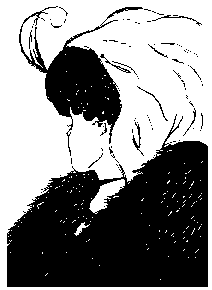Optical Illusions
What do you see in the picture below? A duck?
Or do you se a rabbit? Do you see both now, switching back and forth between rabbit ears and duck beak?
What about here? Is this a young woman, wearing a feathered, flowing veil looking back into the distance?
Or do you see an old woman looking down? Maybe you see both now.
Optical illusions like those above are all about perception. Our brain conflicts with what we’re seeing and what we think we see. This conflict causes us to perceive things often incorrectly. Like this illusion:
It looks like the red lines in the center are bending, even curved. But we know that they are not. The red lines are straight lines. Our perception doesn’t always match reality. The illusion deceives us temporarily. Our visual ability is faster than our ability to think about what we are seeing. (Light travels faster than our ability to process what we see. The linked article above explains how this helps us out in everyday life and how optical illusions work.)
Sometimes we can’t see things until someone points them out to us. You see the duck and the rabbit now, don’t you? You see the old woman and the young lady. Your perception and understanding of the pictures has changed, now that you’d have time to process what you see, and it’s been pointed out to you.
I think these illusions relate so well to aid in our understanding of perception and social role valorization. (For a brief catch-up on social role valorization check out Katie’s beautiful post last year SRV (in grandpa’s words).
SRV, like illusions, work similarly. It is about perception. The image of people with disabilities can be seen through a distorted understanding from our own perception. An optical illusion, if you will. But once you see it, it’s hard not to. The SRV lens is hard to turn off sometimes, and it becomes really easy to be critical of other staff, other programs, other people instead of turning an inward lens to personal changes.
I never noticed that I was asking adults in Starfire U to do childish things, and didn’t perceive what I was doing that to be bad, until Janet Klees called out the activities of the “Sunshine Club” in Louisville. If you read the link from July 2010, you’ll see that we were confronted with a deep challenge in seeing what we were told, and beginning to perceive things differently. (Not just seeing the rabbit, but also seeing the duck.) Janet Klees had pointed out things we’d never noticed before, things we’d never thought of, and things we still couldn’t quite yet see. Much of this SRV learning in Louisville was stuff we didn’t really want to hear. SRV can be hard, heavy, and it can be easy to turn your nose up at the thought of it, and some of it’s principles.
In hindsight, and the passage of time, and in deep thinking and learning, of course parking lot Olympics with fake laurel crowns was not taking people’s lives seriously, was incredibly devaluing.
Three years later, I can’t not see a lot of what once was invisible to me. I notice much differently, and undersand how those strong perceptions are harmful to people living a good life. (I should note that no one is perfect at seeing these devalued images, roles, associations. Sometimes, we’ll plan something, do something, say something, align with someone or something that will make us scratch our heads later, slap our foreheads, and sigh. We’re not perfect. But if you read this reflection you’ll see this isn’t a path to perfection, there are no secret codes to live by, just a stronger understanding that there are some good and meaningful ways we can spend our time with people that builds image positively, social capital, networks, and things that do not, like going out to lunch with 15 people at a Max & Erma’s, and sitting in a private, separate room, or Santa Claus like Tim so bravely wrote about and references often.
So if we know our vision travels faster than our brains ability to process it, what does this mean for the image of people with disabilities, knowing that already, people perceive incorrectly?
It means we have to bend over backwards to make sure the best foot is put forward, as much as possible. Let’s be clear– this isn’t about pretending disability doesn’t exist. This is however, about not letting disability be the main topic of conversation. If you been reading this, following us on Twitter, liking our Facebook statuses, you’ll know that we think about this quite a bit– as in all the time.
There’s a responsibility on our part as well to stop perpetuating myths about people. To help people see that perceptions are not always correct. But first, we have to be aware that people that are devalued already have the deck stacked against their favor. Disability isn’t a valued term in most circles. Disability is most often seen as different, and that difference is negative.
I know a man who wears a Snow White & the Seven Dwarves t-shirt pretty regularly. The shirt says “I’m Dopey!” and features said character on the front. While I know this person to be skilled in a few different things, most people do not know this about him. When he wears this particular shirt the illusion is that this 28 year old man, with a disability, is both a child, liking children’s movies and Disney, and dopey. Dopey isn’t a valued way to be know; It means “stupefied” or “idiotic.”
Perhaps you’ll argue that SRV when it comes to image is just about picking on people or being mean. Who cares about what people wear? It’s their choice!, we’ve heard, many times. But we already know that image and our perception shape how we think about something or someone. And we’re up against a lot to change the public perception that people with disabilities aren’t violent perpetrators of crime or menaces to society, vegetables or subhuman, forever children, holy innocents, objects of ridicule, charity cases, burdensome, or sickly. (Google disability and any of those terms and you’ll find enough articles and YouTube videos to keep you busy for months perpetuating those myths. I’ve linked a few already).
Identify the COLOR of the words above. Read each COLOR aloud.
You’ll struggle to say GREEN out loud when your brain is reading RED. It’s hard to say YELLOW when you’re reading BLACK. The same is true for the image of people with disabilities. It’s difficult to see a person as an adult, when their dress, activity, or role they take part in, is saying otherwise.
With perception and image, we have to do the same thing. We have pause and think. Take a second look and recognize that others will perceive Dopey t-shirts (or pigtails as a grown woman, or overgrown toenails and sandals, or talking about someone in front of them as if they’re not there, or walking 20 feet ahead of the person you’re with, or giving adults plastic kiddie fire hats) as a negative thing. We hear arguments that SRV is just being oversensitive, that “I could wear pigtails and Disney shirts and sweatpants out in public and no one would care!” And I could, and probably no one would care. But I also am married, own my own house, drive my own car, have a full-time job, volunteer in my neighborhood, and have many other valued roles. I have status to spare, and people might think I’m being ironic, sarcastic, or that I’m just so busy running errands to get dressed, even.
We have to stretch though and recognize the optical illusion that can occur when what we see about a person with a disability, confirms what we already think about disability as a whole. If you already perceive people with disabilities as forever children, or charity cases, or objects of pity then when you see someone who has a disability in a childish role, it confirms what you already thought. I can’t tell you how many times there has been a “special sale” on Coca-Cola, coffee, cheese coneys, t-shirts, or “please, just take it…” just because the person ordering had a disability. It is charity that is being offered, not friendship.
We have to be aware of these illusions that trick people, and help people with disabilities avoid negative associations, and stretch to make perception, interpretation, and association, a positive one. People with disabilities are the most at risk at not having their lives taken seriously. We know this.
We have to recognize that most people with disabilities don’t have status to spare, and there is no value in being perceived as worthless.
It is the worst kind of illusion.



